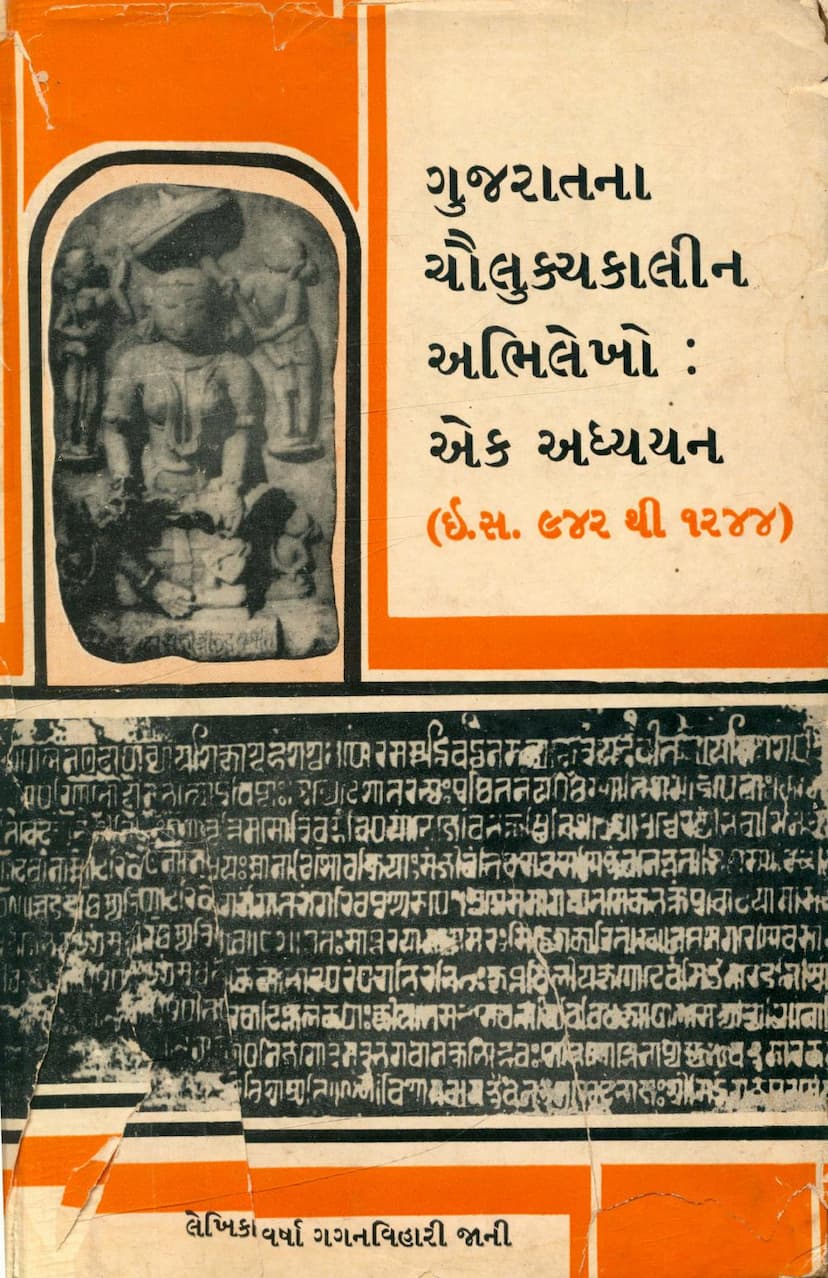Gujaratna Chaulukya Kalin Abhilekho
Added to library: September 1, 2025

Summary
Summary of "Gujaratna Chaulukya Kalin Abhilekho : Eka Adhyayan" by Dr. Varsha Gaganvihari Jani
This book, "Gujaratna Chaulukya Kalin Abhilekho : Eka Adhyayan" (Inscriptions from the Chaulukya Period in Gujarat: A Study), authored by Dr. Varsha Gaganvihari Jani and published by Lilaben K. Jani, is a comprehensive academic study of inscriptions from the Chaulukya (Solanki) period in Gujarat, spanning from AD 942 to 1244. The book aims to provide a detailed analysis of these inscriptions, which are crucial contemporary sources for understanding the political, social, economic, religious, and artistic history of Gujarat during this significant era.
Key aspects covered in the book include:
-
Introduction and Importance of Inscriptions: The book begins by emphasizing the paramount importance of epigraphy in reconstructing history, particularly when literary sources are limited or biased. It highlights how inscriptions, being contemporary records etched on durable materials, offer invaluable and often unadulterated information.
-
Methodology of Study: Dr. Jani outlines the methodology employed, including the reading, publication, and cataloging of inscriptions. She discusses the classification of inscriptions based on their medium (stone, copper plates, images) and content. The study also addresses the challenges of deciphering scripts and understanding the languages (primarily Sanskrit, with some Arabic and Persian) of the period.
-
Detailed Analysis of Inscriptions: The core of the book is the extensive analysis of various types of inscriptions, categorized as follows:
- Inscriptions on Stone: These include rock inscriptions, stone tablets (shilaphalak), and pillar inscriptions (shilastambhalekh).
- Memorial Stones (Paliyalekh): Commemorating brave warriors or virtuous women (sati), these provide insights into social customs and beliefs.
- Inscriptions on Images (Pratimalekh): Often found on sculptures of deities, these typically record the consecration and donation details.
- Copper Plate Grants (Tamrapatra): These are crucial for understanding land grants, administrative divisions, and royal decrees, providing vital information about economic and political aspects.
-
Linguistic and Paleographic Analysis: The book delves into the language and script of the inscriptions. It analyzes the evolution of the Nagari script during the Chaulukya period, highlighting characteristic features of the calligraphy, letter forms, ligatures, and abbreviations. The use of various numerical symbols and their evolution is also discussed.
-
Categorization of Inscriptions by Content: Dr. Jani categorizes the inscriptions based on their primary purpose:
- Land Grants (Danashasan): These are the most numerous and provide detailed information about land ownership, administrative units, donations to religious institutions and Brahmins, and the economic conditions.
- Inscriptions related to Public Works (Purtadharma): These record the construction or renovation of temples, water reservoirs (lakes, step-wells, wells), fortresses, memorial pillars, and public amenities, reflecting the philanthropic and architectural activities of the rulers and nobles.
- Inscriptions related to Image Consecration (Pratimalekh): These primarily detail the establishment and consecration of religious images, offering insights into religious practices and patronage.
- Praise Inscriptions (Prashasti): These are often poetic eulogies of rulers, detailing their conquests, achievements, and lineage, providing valuable historical narratives.
-
Chronology and Dating: A significant portion of the book is dedicated to establishing a chronological framework for the Chaulukya rulers and their reign. It critically examines the dating of inscriptions, discussing the usage of various calendars like the Vikram Samvat, Shaka Samvat, Valabhi Samvat, and the intriguing "Simha Samvat," analyzing their origins and interrelationships.
-
Political Context: The book reconstructs the political history of the Chaulukyas, tracing the lineage from its origins, territorial expansion, relations with contemporary dynasties (Paramaras, Chahamanas, Chudasamas, Jethwas, Kadambas, etc.), and internal political dynamics. It highlights the reigns of prominent rulers like Mulraj I, Bhimdeva I, Karnadeva, Jayasinh Siddhraj, Kumarpal, and Bhimdeva II, elaborating on their military campaigns and administrative policies based on epigraphic evidence.
-
Social and Economic Conditions: The inscriptions provide a rich tapestry of social life, revealing details about the caste system, various guilds and communities (Brahmins with their numerous sub-castes like Nagars, Modhs, Shrimallis, Audichyas; Kshatriyas like Rajputs, Chudasamas, Jethwas; Vaishyas like Maheswaris, Modhs, Oswals, Porwads, etc.), the status of women, human names, place names, and customs. Economic aspects like agriculture, trade, revenue systems, currency, weights and measures, and interest rates are also discussed, drawing inferences from the information gleaned from the inscriptions.
-
Religious Life: The inscriptions offer a detailed account of the religious landscape of the period. They highlight the prevalence of Shaivism, Vaishnavism, and Shaktism, along with the significant patronage of Jainism. The book details donations to various temples and monasteries, the construction of religious structures, the lives and contributions of Jain monks and Acharyas, and the prevalence of religious festivals and rituals.
-
Art and Architecture: Epigraphic references to architectural marvels like forts, step-wells (vav), temples, water reservoirs, and commemorative pillars are analyzed. The book discusses the artistic styles and influences evident in the sculptural representations mentioned in the inscriptions.
-
Appendices and Bibliography: The book includes extensive appendices, such as a list of villages mentioned in the inscriptions, a compilation of inscription dates, a review of Muslim inscriptions from the period, a critical analysis of specific Chaulukya inscriptions, and a comprehensive bibliography of primary and secondary sources. This meticulous documentation enhances the book's scholarly value.
Overall Contribution:
"Gujaratna Chaulukya Kalin Abhilekho : Eka Adhyayan" stands as a monumental work in the field of Indian epigraphy and the history of Gujarat. Dr. Varsha Jani's rigorous research, meticulous analysis, and comprehensive presentation of epigraphic data provide an unparalleled resource for scholars, researchers, and students interested in the Chaulukya period. The book not only reconstructs the political and administrative framework but also illuminates the multifaceted social, economic, religious, and cultural life of Gujarat during this golden age.